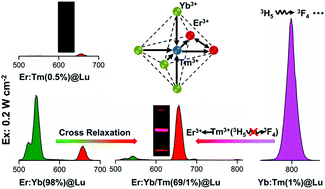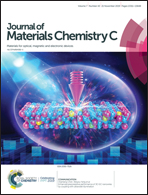Low power density 980 nm-driven ultrabright red-emitting upconversion nanoparticles via synergetic Yb3+/Tm3+ cascade-sensitization†
Abstract
Achieving a bright red upconverting emission under a low excitation power density is the sole approach to address the issues of tissue overheating and limited penetration depth for the classic 980 nm-driven green-emitting UCNPs. Herein, for the first time, synergetic Yb3+/Tm3+ cascade-sensitized NaErF4 with a high quantum yield under a low excitation power density was developed for the to address the above issues. In detail, high levels (e.g., 69%) of Yb3+ were used as the sensitizer to realize the efficient population of the 3H5 state of co-doped (e.g., 1%) energy-bridging Tm3+ ions. Moderate Er3+ content (e.g., 30%) provided suitable Er3+–Er3+ cross-relaxation, sufficient bridging of energy utilizing centers (Tm3+(3H5) → Er3+(4I13/2)), and restrained coupled surface and concentration quenching effects for synergistic red emission and red-to-green ratio enhancement. Incredibly, an optimized nanostructure provides a single chromatic red emission with a red-to-green ratio as high as ∼25.0, and a 53.5-fold intensity enhancement for the red emission as compared with that of the well-known, highly efficient β-NaYF4:Yb/Er. The first example of Yb3+ → Tm3+ → Er3+ cascade-sensitized ultrabright UCNPs exhibits an intense red emission even under an extremely low excitation power density of 0.2 W cm−2, showing great attractiveness for biological applications.



 Please wait while we load your content...
Please wait while we load your content...